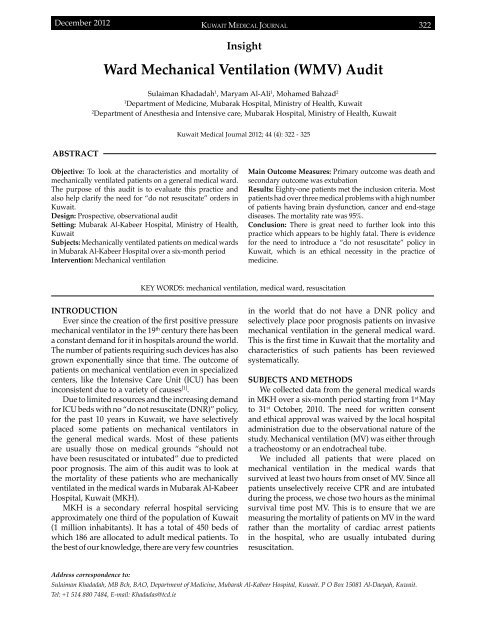Vol 44 # 4 December 2012 - Kma.org.kw
Vol 44 # 4 December 2012 - Kma.org.kw
Vol 44 # 4 December 2012 - Kma.org.kw
You also want an ePaper? Increase the reach of your titles
YUMPU automatically turns print PDFs into web optimized ePapers that Google loves.
<strong>December</strong> <strong>2012</strong><br />
KUWAIT MEDICAL JOURNAL 322<br />
Insight<br />
Ward Mechanical Ventilation (WMV) Audit<br />
Sulaiman Khadadah 1 , Maryam Al-Ali 1 , Mohamed Bahzad 2<br />
1<br />
Department of Medicine, Mubarak Hospital, Ministry of Health, Kuwait<br />
2<br />
Department of Anesthesia and Intensive care, Mubarak Hospital, Ministry of Health, Kuwait<br />
ABSTRACT<br />
Kuwait Medical Journal <strong>2012</strong>; <strong>44</strong> (4): 322 - 325<br />
Objective: To look at the characteristics and mortality of<br />
mechanically ventilated patients on a general medical ward.<br />
The purpose of this audit is to evaluate this practice and<br />
also help clarify the need for “do not resuscitate” orders in<br />
Kuwait.<br />
Design: Prospective, observational audit<br />
Setting: Mubarak Al-Kabeer Hospital, Ministry of Health,<br />
Kuwait<br />
Subjects: Mechanically ventilated patients on medical wards<br />
in Mubarak Al-Kabeer Hospital over a six-month period<br />
Intervention: Mechanical ventilation<br />
Main Outcome Measures: Primary outcome was death and<br />
secondary outcome was extubation<br />
Results: Eighty-one patients met the inclusion criteria. Most<br />
patients had over three medical problems with a high number<br />
of patients having brain dysfunction, cancer and end-stage<br />
diseases. The mortality rate was 95%.<br />
Conclusion: There is great need to further look into this<br />
practice which appears to be highly fatal. There is evidence<br />
for the need to introduce a “do not resuscitate” policy in<br />
Kuwait, which is an ethical necessity in the practice of<br />
medicine.<br />
KEY WORDS: mechanical ventilation, medical ward, resuscitation<br />
INTRODUCTION<br />
Ever since the creation of the first positive pressure<br />
mechanical ventilator in the 19 th century there has been<br />
a constant demand for it in hospitals around the world.<br />
The number of patients requiring such devices has also<br />
grown exponentially since that time. The outcome of<br />
patients on mechanical ventilation even in specialized<br />
centers, like the Intensive Care Unit (ICU) has been<br />
inconsistent due to a variety of causes [1] .<br />
Due to limited resources and the increasing demand<br />
for ICU beds with no “do not resuscitate (DNR)” policy,<br />
for the past 10 years in Kuwait, we have selectively<br />
placed some patients on mechanical ventilators in<br />
the general medical wards. Most of these patients<br />
are usually those on medical grounds “should not<br />
have been resuscitated or intubated” due to predicted<br />
poor prognosis. The aim of this audit was to look at<br />
the mortality of these patients who are mechanically<br />
ventilated in the medical wards in Mubarak Al-Kabeer<br />
Hospital, Kuwait (MKH).<br />
MKH is a secondary referral hospital servicing<br />
approximately one third of the population of Kuwait<br />
(1 million inhabitants). It has a total of 450 beds of<br />
which 186 are allocated to adult medical patients. To<br />
the best of our knowledge, there are very few countries<br />
in the world that do not have a DNR policy and<br />
selectively place poor prognosis patients on invasive<br />
mechanical ventilation in the general medical ward.<br />
This is the first time in Kuwait that the mortality and<br />
characteristics of such patients has been reviewed<br />
systematically.<br />
SUBJECTS AND METHODS<br />
We collected data from the general medical wards<br />
in MKH over a six-month period starting from 1 st May<br />
to 31 st October, 2010. The need for written consent<br />
and ethical approval was waived by the local hospital<br />
administration due to the observational nature of the<br />
study. Mechanical ventilation (MV) was either through<br />
a tracheostomy or an endotracheal tube.<br />
We included all patients that were placed on<br />
mechanical ventilation in the medical wards that<br />
survived at least two hours from onset of MV. Since all<br />
patients unselectively receive CPR and are intubated<br />
during the process, we chose two hours as the minimal<br />
survival time post MV. This is to ensure that we are<br />
measuring the mortality of patients on MV in the ward<br />
rather than the mortality of cardiac arrest patients<br />
in the hospital, who are usually intubated during<br />
resuscitation.<br />
Address correspondence to:<br />
Sulaiman Khadadah, MB Bch, BAO, Department of Medicine, Mubarak Al-Kabeer Hospital, Kuwait. P O Box 15081 Al-Daeyah, Kuwait.<br />
Tel: +1 514 880 7484, E-mail: Khadadas@tcd.ie
















